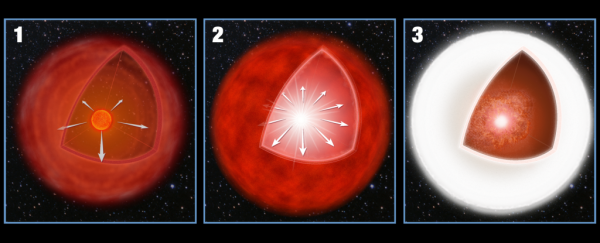When a star goes supernova, it's such a gargantuan process that it usually lasts for months. So when astronomers caught one lasting just a few weeks, they sat up and paid attention - and found a totally new type of supernova never observed before.
The supernova is called KSN 2015K, and it peaked in brightness and then faded completely in under a month, 10 times faster than other supernovae of similar brightness, which typically take months.
According to an international team of researchers, the most likely explanation is that it was shrouded by a cocoon of gas and dust it had already ejected - only becoming visible after the dust was blasted away by the supernova's shockwave.
"We've discovered yet another way that stars die and distribute material back into space," said researcher Brad Tucker of the Australian National University.
Events like these have been captured before. They're called fast-evolving luminous transients, or FELTs, and they have baffled astronomers because they don't align with traditional supernova models.
KSN 2015K was captured by the Kepler telescope in 2015, which photographed the event every 30 minutes for its entire duration - giving an unprecedented level of detail on these peculiar bursts of light.
In just 2.2 days, KSN 2015K rose to a peak brightness comparable to that of a Type Ia supernova - the explosion of a white dwarf in a binary system. Within a week, it had dropped to half that brightness, and faded completely in just 25 days.
The team found that the light curve matched that of a supernova after the star had exploded - without the expected build-up. But if a cocoon of shed material had hidden the star from view, that would explain how the supernova seemed to happen so quickly.
As stars die, they can shed much of their mass in the form of gas and dust into the space around them. Usually, this is lit from within by the star, but if it was dense enough, theoretically it could hide the star's light.
Of course, that then raises the question: what could create such a dense cocoon of material around an unstable star such a short time before its death?
There are several possible culprits, but Type Ia supernovae usually produce an incredible amount of radioactive nickel. Very little nickel was observed in the case of KSN 2015K, as evidenced by how quickly it faded.
The most likely explanation, then, is what is known as an asymptotic giant branch star - a low-to-intermediate-mass red giant gaining in brightness as it dies. If KSN 2015K was on the higher mass end of this type of star, with a very slow, dusty wind blowing around it, this could have created the cocoon. However, red giant supernovae aren't as bright as white dwarf supernovae.
When the core of the star collapsed, the enormous amount of kinetic energy produced by the blast would have converted into light when it slammed into the cocoon, accounting for the extremely bright peak in the light curve.
More observations will help verify this hypothesis - and upcoming telescopes, such as NASA's TESS, will be able to examine FELTs in greater detail and help learn more about their progenitor stars.
"This work also has another legacy," wrote astrophysicist JJ Eldridge of the University of Auckland in an accompanying editorial.
"It shows that ultra-high cadence observations of the sky will be a rich area for future discoveries. For thousands of years we thought that the sky was unchanging. Then the observations of Galactic supernovae detailed in historical records around the world showed us that the sky was changing on human timescales.
"Now these observations of KSN 2015K have shown that the death throes of stars can be even more rapid than we thought."
The research has been published in Nature Astronomy.
